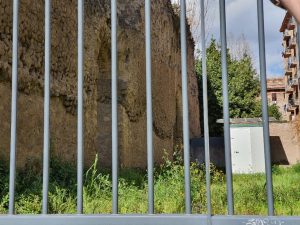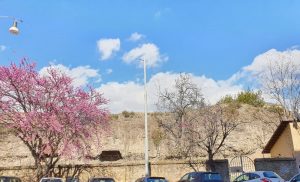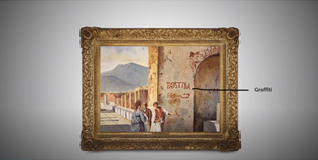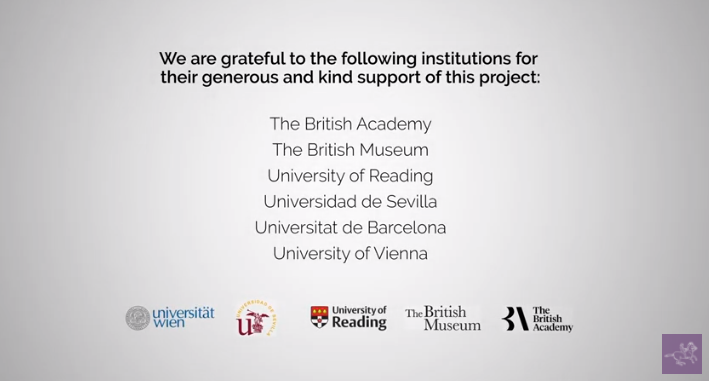Our undergraduate student, Kieran Evans, shares their experience from the first departmental study trip to Rome after the pandemic—in April 2022—along with a series of exciting and wonderful pictures of Rome! Thank you to everyone who participated to this trip, and particularly to Profs Amy Smith and Matthew Nicholls who organised it and led the tour!
It started with a 2:15am meetup at the Sports Park building on campus to catch a coach for Heathrow. We left extra early just to make sure we had enough time for any delays or queues caused by COVID-19 restrictions at the airport. Despite being early hours of the morning, everyone was raring to go to Rome, bags packed, and the anticipation of getting to the airport was at a high. We just had to get through security then a rather long wait for the flight at 7am.
 The arrival into Rome, after the flight and coach journey, was only the start of the day in the ‘Eternal city’. We checked into our hotel in the afternoon, to get set for the first trek of the trip. Matthew Nicholls, our tour lead who came over from Oxford University, but in his role as Visiting Professor at University of Reading, walked us through some parts of the southern part of the city, checking out Roman building remains, seeing what remained of the concrete. One major theme of the trip was the material left behind in buildings, mostly the concrete that the marble would have covered up. From the first tour we saw how the massive structures, like the Porticus Aemilia, a long series of arched warehouses for food storage, or acting as a naval dockyard. They were impressive to look at, considering the size and how long they’ve been around, but like many Roman buildings the concrete lost the marble exterior, looted for other construction, or turned into lime. That same afternoon we came across one of the best views of the trip. From the top of the Aventine Hill, you could see across the city with St. Peter’s Basilica to the north peeking above the buildings before it. It became somewhat a preview of what to expect for the coming days, just spectacular.
The arrival into Rome, after the flight and coach journey, was only the start of the day in the ‘Eternal city’. We checked into our hotel in the afternoon, to get set for the first trek of the trip. Matthew Nicholls, our tour lead who came over from Oxford University, but in his role as Visiting Professor at University of Reading, walked us through some parts of the southern part of the city, checking out Roman building remains, seeing what remained of the concrete. One major theme of the trip was the material left behind in buildings, mostly the concrete that the marble would have covered up. From the first tour we saw how the massive structures, like the Porticus Aemilia, a long series of arched warehouses for food storage, or acting as a naval dockyard. They were impressive to look at, considering the size and how long they’ve been around, but like many Roman buildings the concrete lost the marble exterior, looted for other construction, or turned into lime. That same afternoon we came across one of the best views of the trip. From the top of the Aventine Hill, you could see across the city with St. Peter’s Basilica to the north peeking above the buildings before it. It became somewhat a preview of what to expect for the coming days, just spectacular.
 On day Two we visited monuments fitting the theme ‘Landscape of Victory’. Amy and Matthew had organised entering the Mausoleum of Augustus, very recently opened to the public. Such a grand monument which held the first imperial dynasty, was left in a state of ruin for years and recently restored for visitors to re-enter. Walking through the crypt we saw how the material again was laid bare, and how the diamond patterns bricks were organised into in the concrete. Some marble—the only marble left—greeted us at the entrance telling of how this place held the ashes of Augustus and his family. The building was remarkable to walk through. Like at all sites on the trip, Matthew and Amy told us everything there was to know, the way it looked when constructed, a wedding cake style of tiers of earth and trees planted on top and the history following. Somewhat surprising to hear was that, when the top tier collapsed, it filled the interior to create a new ground level above the original entrance and a space for a bull fighting arena. 16th-century entertainment turned it into a stage for the sport, then a theatre in the 20th century. It’s restored and the grand entrance is the only way in now, not the archway some 30 feet above it.
On day Two we visited monuments fitting the theme ‘Landscape of Victory’. Amy and Matthew had organised entering the Mausoleum of Augustus, very recently opened to the public. Such a grand monument which held the first imperial dynasty, was left in a state of ruin for years and recently restored for visitors to re-enter. Walking through the crypt we saw how the material again was laid bare, and how the diamond patterns bricks were organised into in the concrete. Some marble—the only marble left—greeted us at the entrance telling of how this place held the ashes of Augustus and his family. The building was remarkable to walk through. Like at all sites on the trip, Matthew and Amy told us everything there was to know, the way it looked when constructed, a wedding cake style of tiers of earth and trees planted on top and the history following. Somewhat surprising to hear was that, when the top tier collapsed, it filled the interior to create a new ground level above the original entrance and a space for a bull fighting arena. 16th-century entertainment turned it into a stage for the sport, then a theatre in the 20th century. It’s restored and the grand entrance is the only way in now, not the archway some 30 feet above it.
 My personal highlight of the trip was later in the day on visiting another monument, the Pantheon. Despite looking majestic from the front with the granite columns and inscription to Agrippa, it took a second to realise what I was looking at when we approached it from the south, only seeing the circular, brick building. Of course, when I finally recognised it, I got a little giddy. About an hour and a half before entering we had a lunch break and some of us found a restaurant on the piazza of the Pantheon. It was somewhat surreal sitting there eating proper Italian pizza and looking at the entrance of this building less than a hundred metres to my left.
My personal highlight of the trip was later in the day on visiting another monument, the Pantheon. Despite looking majestic from the front with the granite columns and inscription to Agrippa, it took a second to realise what I was looking at when we approached it from the south, only seeing the circular, brick building. Of course, when I finally recognised it, I got a little giddy. About an hour and a half before entering we had a lunch break and some of us found a restaurant on the piazza of the Pantheon. It was somewhat surreal sitting there eating proper Italian pizza and looking at the entrance of this building less than a hundred metres to my left.
 The group that went on the trip were great, insofar as everyone got on so well with each other, making meals out easier and so much more fun. Especially the final evening we all had in Rome, dining at Il Matto and drinking plenty of red wine with the excellent food. Amy and Matthew organised an amazing series of tours across the 6 days we were there. I cannot think of how that trip could have been better… maybe if we had another day there?
The group that went on the trip were great, insofar as everyone got on so well with each other, making meals out easier and so much more fun. Especially the final evening we all had in Rome, dining at Il Matto and drinking plenty of red wine with the excellent food. Amy and Matthew organised an amazing series of tours across the 6 days we were there. I cannot think of how that trip could have been better… maybe if we had another day there?









 Thank you so much for this – it’s great for us to be back for a little while, albeit virtually. All three of us share the same passion: our enthusiasm for Roman inscriptions, especially inscriptions composed in verse. To us, those inscriptions are not just stones or pieces of metal that happen to have some poetry inscribed on them. They are carriers of art. They are visible, tangible manifestations of a universal artistic practice of Roman times, spanning the empire across time and space, with thousands of examples surviving to the present day.
Thank you so much for this – it’s great for us to be back for a little while, albeit virtually. All three of us share the same passion: our enthusiasm for Roman inscriptions, especially inscriptions composed in verse. To us, those inscriptions are not just stones or pieces of metal that happen to have some poetry inscribed on them. They are carriers of art. They are visible, tangible manifestations of a universal artistic practice of Roman times, spanning the empire across time and space, with thousands of examples surviving to the present day.

 We wanted to make a number of strong, important points. About the way in which we perceive, in which we encounter the Roman world. About the way the ancient world is presented to us in museums, archives, exhibitions, and books. And we want to do so while racing a wide audience because what we have to say and offer is relevant to so many different audiences.
We wanted to make a number of strong, important points. About the way in which we perceive, in which we encounter the Roman world. About the way the ancient world is presented to us in museums, archives, exhibitions, and books. And we want to do so while racing a wide audience because what we have to say and offer is relevant to so many different audiences. We want to enthuse new generations with our passion for Roman history, for poetry, for epigraphy. We want to give teachers the opportunity to expand the canon of teaching through the inclusion of poetry that students can easily relate to. We want to invite museums, collections, and policymakers to rethink their approach to the way in which these incredibly exciting, talking objects from the ancient world are displayed. What better way to achieve this than to choose a text that expresses, in such beautiful words, the grief of pet owners – whose faithful companion had died. We feel we all can relate to that, and we feel that this text alone opens up so many new ways of thinking about the Roman world and the people who “were” the Romans, than the ever-same repertoire of classical authors.
We want to enthuse new generations with our passion for Roman history, for poetry, for epigraphy. We want to give teachers the opportunity to expand the canon of teaching through the inclusion of poetry that students can easily relate to. We want to invite museums, collections, and policymakers to rethink their approach to the way in which these incredibly exciting, talking objects from the ancient world are displayed. What better way to achieve this than to choose a text that expresses, in such beautiful words, the grief of pet owners – whose faithful companion had died. We feel we all can relate to that, and we feel that this text alone opens up so many new ways of thinking about the Roman world and the people who “were” the Romans, than the ever-same repertoire of classical authors.
 Haha, oh dear! Well… none of us are natural-born entertainers. We all were terrified and at first, we hated to see our faces and hear our recorded voices. But
Haha, oh dear! Well… none of us are natural-born entertainers. We all were terrified and at first, we hated to see our faces and hear our recorded voices. But  We hope that putting this video out there will make it available for generations to come – for pupils, teachers, academics, cultural managers, policy makers: it should entertain and be useful at the same time! It’s genuinely a piece of art.
We hope that putting this video out there will make it available for generations to come – for pupils, teachers, academics, cultural managers, policy makers: it should entertain and be useful at the same time! It’s genuinely a piece of art.


 Mairs, Rachel (Ed.) 2021. The Graeco-Bactrian and Indo-Greek World. Routledge.
Mairs, Rachel (Ed.) 2021. The Graeco-Bactrian and Indo-Greek World. Routledge.
 Marzano, Annalisa. 2021. Caesar’s triumphal banquet of 46 BC: A Hypothesis on its Political Significance on the Basis of a Recent Epigraphic Discovery from Pompeii in: politica antica 10: 99-107.
Marzano, Annalisa. 2021. Caesar’s triumphal banquet of 46 BC: A Hypothesis on its Political Significance on the Basis of a Recent Epigraphic Discovery from Pompeii in: politica antica 10: 99-107. Finglass, P.J., Kelly, A. (Eds.) 2021. The Cambridge Companion to Sappho. Cambridge University Press. With chapters by Harloe, K, Goff, B.
Finglass, P.J., Kelly, A. (Eds.) 2021. The Cambridge Companion to Sappho. Cambridge University Press. With chapters by Harloe, K, Goff, B.
